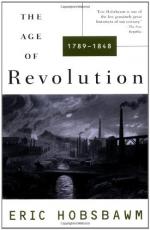
|
| Name: _________________________ | Period: ___________________ |
This test consists of 5 multiple choice questions, 5 short answer questions, and 10 short essay questions.
Multiple Choice Questions
1. How were Charles Dickens' novels connected to the politics of Dickens' time, in Hobsbawm's account?
(a) They depicted the eternal struggles of boys and men.
(b) They depicted the history of industrialism.
(c) They depicted the consequences of the Napoleonic Wars.
(d) They depicted the horrible working class conditions.
2. What was the new stance toward religion after the French Revolution?
(a) Radicals were openly antagonistic to the church.
(b) People were not hostile, but society was becoming more secular.
(c) The state had seized all church lands, and the church was diminished.
(d) The church had insinuated itself into the government.
3. In what way, in Hobsbawm's account, did the nobility use religion?
(a) As an expensive charity to donate to.
(b) As a source of stability and legitimacy.
(c) As a prop to demonstrate their conspicuous leisure.
(d) As a club to keep the lower classes down.
4. How does Hobsbawm describe the traditional system of agriculture?
(a) As the foundation for industrialism.
(b) As a backwards set of superstitions.
(c) As a hindrance to economic growth.
(d) As a legacy of improvements.
5. How was the European population changing that made it possible for art to flourish during the Age of Revolution?
(a) The upper classes had more disposable income.
(b) People were more literate.
(c) People were wealthier.
(d) The upper classes could travel to artistic centers to buy art.
Short Answer Questions
1. What tool did the upper classes use to discriminate against the working poor?
2. In Hobsbawm's account, what did the peasantry lose by land reforms sweeping the globe in the mid-1800s?
3. What does Hobsbawm say was the realm of all important thought at the time?
4. What did Hobsbawm find in conservative thinking of the period?
5. When, in Hobsbawm's opinion, did the rate of change begin to increase quickly?
Short Essay Questions
1. What happened in France while the rest of Europe was industrializing?
2. What opportunities were open because of the Industrial Revolution that were not open before, in Hobsbawm's account?
3. Why, in Hobsbawm's account, was Britain the only industrialized nation in 1848?
4. How does Hobsbawm say France in particular created opportunities for a new middle class?
5. What works marked the beginning and the peak, respectively, of middle class ideology, in Hobsbawm's account?
6. Which religions were expanding as the Catholic Church's importance was declining?
7. How does Hobsbawm describe France's effect on land reform?
8. What role did religion serve, even as Europe was becoming more secular?
9. What does Hobsbawm say were the three paths a working class person could choose in 1848?
10. What are the three sources Hobsbawm refers to when he says that artists made the effects of industrialization a common theme?
|
This section contains 758 words (approx. 3 pages at 300 words per page) |

|




